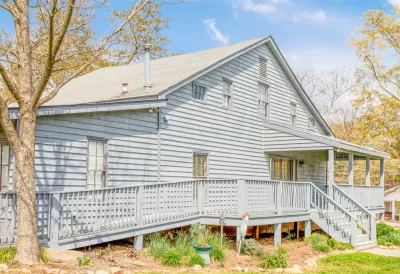One USDA program has given out over $1 billion in rural home repair grants since its inception, and could be inspiration for similar programs in urban and suburban communities as well.

Betty Lunce is in her 70s and walks with a cane. A homeowner in Hazard, Kentucky, she found it difficult to leave her house. As Scott McReynolds, the executive director of the nonprofit Housing Development Alliance (HDA) explains, the back door led to three uneven, precarious steps with no handrail, and her long gravel driveway was near impassable due to deep ruts that had formed. Even though she no longer drove, the damaged driveway prevented any cars from pulling up to the home unless they had four-wheel drive. She and her family were unsure if an ambulance would be able to reach her home in an emergency. Even more concerning was her roof, which leaked in several spots including the kitchen and could lead to structural issues such as drywall damage or wood rot, and health issues such as the spread of mold.
All of that changed in December 2021, however, when Lunce received a new roof, an entry ramp, and a rebuilt driveway, for a total cost of $12,300, as part of a relatively unknown federal resource known as Section 504, and described as the U.S. Department of Agriculture’s (USDA) home repair loan and grant program for very low-income rural homeowners.
Lunce is one of many Americans living in rural communities who may own a home but have difficulty affording maintenance and repairs. The HDA worked with Lunce to qualify her for aid and link her to financing using Section 504. In addition to the loan and grant provided by the USDA program...
FULL STORY: Leaky Roof? A USDA Home Repair Option

Planetizen Federal Action Tracker
A weekly monitor of how Trump’s orders and actions are impacting planners and planning in America.

Maui's Vacation Rental Debate Turns Ugly
Verbal attacks, misinformation campaigns and fistfights plague a high-stakes debate to convert thousands of vacation rentals into long-term housing.

Restaurant Patios Were a Pandemic Win — Why Were They so Hard to Keep?
Social distancing requirements and changes in travel patterns prompted cities to pilot new uses for street and sidewalk space. Then it got complicated.

In California Battle of Housing vs. Environment, Housing Just Won
A new state law significantly limits the power of CEQA, an environmental review law that served as a powerful tool for blocking new development.

Boulder Eliminates Parking Minimums Citywide
Officials estimate the cost of building a single underground parking space at up to $100,000.

Orange County, Florida Adopts Largest US “Sprawl Repair” Code
The ‘Orange Code’ seeks to rectify decades of sprawl-inducing, car-oriented development.
Urban Design for Planners 1: Software Tools
This six-course series explores essential urban design concepts using open source software and equips planners with the tools they need to participate fully in the urban design process.
Planning for Universal Design
Learn the tools for implementing Universal Design in planning regulations.
Heyer Gruel & Associates PA
JM Goldson LLC
Custer County Colorado
City of Camden Redevelopment Agency
City of Astoria
Transportation Research & Education Center (TREC) at Portland State University
Jefferson Parish Government
Camden Redevelopment Agency
City of Claremont


























